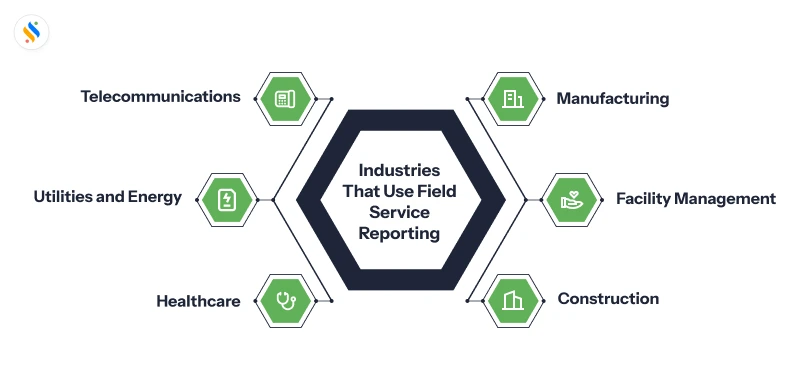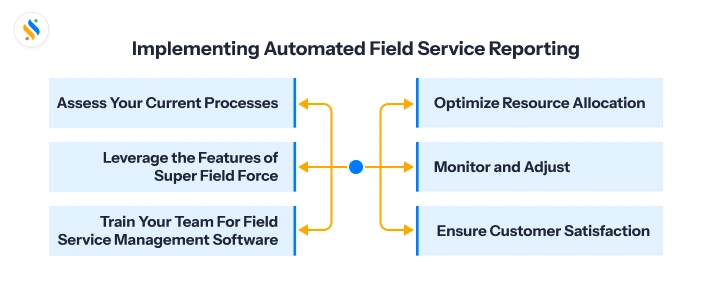
Field service reporting to be honest is no longer just a task of logging service activities! Rather it’s quite a crucial process for businesses that keep improving operational efficiency and customer satisfaction. And once you automate such reporting, then you can seamlessly eliminate paper-based processes, and keep the manual errors, next to none!
With automated reports, businesses can easily gain real-time insights that directly help in resource allocation, service quality improvements, and also in cost reduction. The reason behind this dire need for automation just so that field technicians and managers can access the tools to record, analyze, and act on data quickly!
These field time tracking systems with mobile forms can create comprehensive reports that enable businesses to track their service history, monitor equipment performance & streamline operational costs. Because with automation, field service operations can become more efficient, and easily empower organizations to meet customer expectations much more effectively while enhancing customer experiences.
This transformation isn’t just about convenience— rather it’s more about creating a significant impact on business operations. So, let’s start exploring how automated reporting works and why it really is a game-changer for modern businesses.
What is Field Service Reporting?
Field service reporting is a critical process of recording & analyzing data related to service activities performed by field technicians. These reports capture details about tasks such as equipment maintenance, service requests, site visits, and customer interactions.
Traditionally, this reporting was handled manually through paper-based processes, which were time-consuming and prone to errors. Modern field service report software has revolutionized this by enabling field workers to log technician information, service appointments, and inspection summaries digitally, often using mobile forms on devices.
Key elements of field service reporting include:
- Service History Tracking: Helps businesses understand the performance of customer assets over time.
- Real-Time Access to Data: Allows managers and technicians to track ongoing operations and make informed decisions on the go.
- Comprehensive Reports: Provide detailed insights into service quality, customer satisfaction & resource allocation.
Such reporting always ensures that businesses are staying on top of their service operations! These reports continue to enable companies to improve operational efficiency, meet customer expectations, & streamline field service management.
How Automated Field Service Reporting Can Save Time & Money?
Automated reporting of this kind is a game-changer for businesses looking to streamline operations & reduce costs. By replacing manual, all kinds of paper-based processes with automated workflows, companies can easily save valuable time & resources. Here’s how:
- Eliminating Manual Processes: Automation keeps reducing reliance on paper-based reporting, which literally saves time for field service professionals and cuts costs on physical resources.
- Real-Time Insights: Automated systems of these kinds avail real-time access to data, enabling managers to make quick decisions, allocate resources effectively, and avoid delays in service operations.
- Reducing Errors: Digital reporting minimizes human errors often associated with manual data entry, ensuring service reports are accurate and reliable.
- Streamlined Resource Allocation: Automation helps track field service operations, allowing businesses to optimize resource allocation and reduce operational costs.
- Enhancing Customer Satisfaction: Faster service delivery and accurate reporting lead to better customer experiences, helping companies meet customer expectations and boost retention.
Businesses that adopt automated field service reporting not only save time and money but also improve service quality and operational efficiency, giving them a competitive edge in their industry.
Benefits of Automated Field Service Reporting

Automated field service reporting provides diverse advantages that cater to different roles within an organization. Whether it’s optimizing field operations, enhancing service quality, or saving costs, the benefits span across various departments. Below are the specific advantages for field managers, sales heads, and HR managers.
Advantages For Field Managers
- Streamlined Resource Allocation: Real-time insights help assign the right field workers to tasks, reducing downtime and enhancing efficiency.
- Enhanced Visibility into Operations: Managers can track service requests, field visits, and technician information effortlessly.
- Proactive Issue Management: Instant alerts and updates enable managers to address challenges promptly, ensuring customer satisfaction.
- Effective Communication: Mobile tools improve collaboration with technicians, reducing miscommunication and errors.
- Operational Efficiency: Automation minimizes paperwork, allowing managers to focus on optimizing field service operations.
Advantages For Sales Heads
- Real-Time Performance Tracking: Automated reports provide instant insights into sales performance, helping identify trends and areas for improvement.
- Improved Forecasting: Comprehensive data supports accurate sales projections and better resource planning.
- Enhanced Customer Engagement: Field service data reveals customer preferences and issues, enabling sales heads to tailor solutions.
- Streamlined Service Quality Analysis: Sales heads can monitor the service quality delivered to customers, ensuring consistency.
- Cost-Effective Strategies: Automated workflows reduce overhead costs, allowing sales teams to maximize their budgets.
Advantages For HR Managers
- Employee Performance Analytics: HR managers can track the productivity of field service engineers and identify training needs.
- Streamlined Workforce Management: Automation simplifies scheduling and resource allocation, ensuring balanced workloads.
- Improved Employee Satisfaction: Real-time access to performance data encourages transparency and rewards hard work.
- Simplified Recruitment & Retention: Insights from service operations help HR managers align hiring strategies with organizational needs.
- Compliance and Reporting: Automated systems make it easier to generate service reports and maintain compliance with regulations.
These role-specific benefits demonstrate how automated field service reporting improves operational efficiency and helps organizations deliver exceptional service quality.
Unlock the ultimate benefits of automated reporting!
Get Super Field Force & keep delivering exceptional services!
Industries That Use Field Service Reporting

Field service reporting has become an essential tool across a variety of industries, helping businesses optimize their service operations and improve customer satisfaction. Here are some key sectors that benefit from automated field service reporting:
1. Telecommunications
- Telecom field services rely on accurate reporting to manage maintenance plans, resolve service issues, and ensure equipment uptime.
- Automated reports help telecom companies track technician performance, resource allocation, and service history.
2. Utilities and Energy
- Utility companies use field service reporting to monitor inspections, maintenance tasks, and service appointments.
- Real-time insights enhance operational efficiency by reducing downtime and optimizing resource usage.
3. Healthcare
- Medical equipment servicing requires detailed tracking of maintenance activities and service quality.
- Automated reporting helps ensure compliance with strict industry regulations while improving service delivery.
4. Manufacturing
- Field technicians in manufacturing use service reports to track equipment repairs, installations, and preventive maintenance.
- Reports provide managers with actionable data to reduce operational costs and improve service outcomes.
5. Facility Management
- Facility management companies use automated workflows to handle service requests, schedule field visits, and monitor ongoing operations.
- Real-time data helps improve customer engagement by addressing issues promptly.
6. Construction
- Construction companies use field service reporting to track equipment usage, service history, and technician assignments.
- Automated tools ensure effective collaboration and resource allocation on-site.
By implementing automated field service reporting, businesses across these industries enhance their efficiency, meet customer expectations, and maintain a competitive edge.
Implementing Automated Field Service Reporting

Implementing automated field service reporting becomes straightforward and effective with the right tools like Super Field Force. This kind of robust platform is designed to streamline operations, enhance efficiency, and deliver actionable insights, making it an ideal solution for modern businesses. Here’s how to get started:
1. Assess Your Current Processes
- Identify inefficiencies in manual reporting and areas where automation can improve operational efficiency.
- Evaluate your current tools and ensure they can integrate with Super Field Force, which offers powerful field force management features.
2. Leverage the Features of Super Field Force
- With Super Field Force, businesses can:
- Access real-time data updates for better decision-making.
- Generate comprehensive reports to track service history and monitor field operations.
- Use mobile-friendly interfaces, empowering field technicians to log data on the go.
- Seamlessly integrate with existing HRMS and payroll software to unify business operations.
3. Train Your Team For Field Service Management Software
- Onboard your team with Super Field Force through its user-friendly platform and intuitive features.
- Train field service professionals to update technician information, schedule tasks, and utilize real-time insights effectively.
4. Optimize Resource Allocation
- Use Super Field Force to allocate resources like field workers, tools, and equipment more efficiently.
- Automate workflows to eliminate delays and improve first-time fix rates.
5. Monitor and Adjust
- The dashboard on Super Field Force offers real-time tracking of service requests, technician assignments, and operational performance.
- Regularly review reports to identify bottlenecks and refine processes to meet customer expectations.
6. Ensure Customer Satisfaction
- With Super Field Force, businesses can ensure better customer engagement by addressing issues proactively.
- Use automated reports to improve service quality, achieve higher customer satisfaction, and streamline service appointments.
By implementing Super Field Force, businesses gain access to a comprehensive solution tailored to meet the challenges of field service reporting. This tool not only improves operational efficiency but also helps companies deliver exceptional service quality while staying ahead in the industry.
Measuring ROI and Success Metrics of Automated Reports
To gauge the impact of tools like Super Field Force of Superworks’ HRMS & Payroll software, businesses should track these key metrics:
- Operational Costs: Measure savings from reduced paper-based processes and improved resource allocation.
- Efficiency: Track faster resolution times for service requests and field operations.
- First-Time Fix Rates: Monitor the percentage of issues resolved on the first visit, enabled by accurate service history.
- Customer Satisfaction: Use feedback and retention rates to evaluate improved service quality.
- Productivity: Measure the number of completed tasks and reduce downtime for field technicians.
- Revenue Growth: Compare revenue before and after automation to assess profitability.
- Insights for Strategy: Analyze trends in service quality and customer engagement for long-term improvements.
Tracking these metrics ensures businesses understand the value of automation and optimize their strategies for maximum ROI.
Conclusion
You can consider automating field service reporting a strategic advancement that keeps enhancing efficiency, reduces costs & improves customer satisfaction. Tools like Super Field Force streamline operations, minimize errors, and provide real-time insights, empowering your business to stay competitive and responsive.
Embrace automation with field force management software and keep optimizing resource allocation, elevating service quality, and driving growth.








